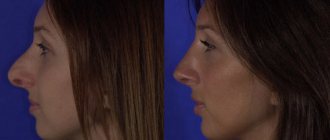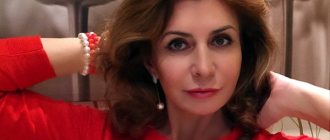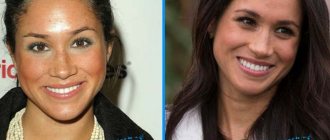A thickened, fleshy tip of the nose, popularly called a “potato”, is not a disease or abnormality. This is only an individual physical feature of a person, which, however, causes obvious psychological discomfort.
- Contour plastic
A large rounded nose stands out sharply on the face, distorting even the most pretty and harmonious features. The GALAXY Beauty Institute successfully corrects this problem using proprietary techniques and advanced technologies.
What does a potato nose look like?
Women's potato noses stand out in the photo. The shape was so named because of its round and wide tip. Owners of this feature in Russia are considered simple-minded and naive. A wide nose can become even larger with age as tissue elasticity is lost.
Recently, small, neat noses with a narrow bridge and tip have become fashionable. Many representatives of the fairer sex resort to all possible methods in pursuit of fashion and beauty.
Potatoes instead of a nose: how is this possible?
This form of the olfactory organ is not without reason compared to a popular tuber: a “potato” is a nose with wide wings and a thickened tip. The combination of genetic characteristics gives its owner a rounded nose shape, devoid of graceful lines and refined outlines.
Even in the womb, it is the genes that decide how certain parts of the child’s face will look. No extraneous factors can affect the natural process of “drawing” the appearance of the future baby. It is useless to fight heredity.
Methods for correcting the shape of the nose
You can correct the shape of your nose to improve its aesthetics without surgery, using injections. To solve the problem of patients with septal deformities and impaired respiratory function, they resort to surgical rhinoplasty.
Non-surgical rhinoplasty
Potato noses in women in photos can be removed using photo editing programs, but in life, most often they resort to non-surgical rhinoplasty. Nose correction using injection plastic surgery allows you to change the shape, size, correct the surgeon’s mistakes after rhinoplasty, and hide skin defects.
Benefits of cosmetic correction:
- lack of long-term rehabilitation;
- there is no swelling or bruising after the procedure;
- general anesthesia is not used;
- the patient can see the changes in real time in the mirror.
The use of general anesthesia, as in the case of surgery, is a risk to the health and life of the patient.
Surgical rhinoplasty
Classic rhinoplasty is now performed using innovative technologies. Instead of a conventional scalpel, surgeons use a laser beam, which eliminates errors and irregularities in the cut line. This technique allows you to immediately seal open capillaries, closing the cut line from infections and bacteria.
Rhinoplasty is considered the most difficult plastic surgery, so not every good surgeon will undertake it just to change a person’s appearance.
The recovery period after surgical rhinoplasty is usually 2 weeks. During this time, a splint is placed on the patient’s nose and a bandage is applied on top. All this time, the person has difficulty breathing, swelling and pain interfere with him.
The advantages of this correction technique:
- correction of serious defects that create discomfort for a person;
- the result of the operation lasts for many years.
The photo shows how a potato nose is corrected in women using rhinoplasty.
Women's potato noses in the photo before surgery look much larger in size than in the photo after the recovery period. But in many cases, the original nose shape looks much more natural.
Methods for fixing your nose with potatoes
Those with this deficiency are thinking about how to get rid of it. How to make your nose smaller.
There are only two methods:
- The first is non-surgical, that is, gentle.
- The second method is surgical, using rhinoplasty.
How to choose a method? Methods are selected individually, depending on the complexity of the defect and what contraindications exist. All this is clarified during communication with the doctor.
Non-surgical rhinoplasty
Potato nose can be visually eliminated using cosmetics without resorting to surgery. This type of rhinoplasty is called non-surgical.
It is designed for the introduction of special helium injections into the nasal cavity. With their help, precise cavities of the nose are hidden, or its general shape is corrected.
There is one significant disadvantage to non-surgical rhinoplasty: the result of the procedure is not long-lasting and will have to be repeated constantly.
- How to fix a woman's nose with potatoes. Rhinoplasty, photos before and after surgery, price
Types of rhinoplasty using injections:
- The tip of the nose is filled with a special gel.
- Hormonal drugs are used. They directly affect soft tissues.
- The use of Ardos threads, with the help of which the nose takes on a different shape.
- Using a splint to model the shape of the nose.
Surgical rhinoplasty
There are several surgical methods to eliminate the potato nose. Which one is right for each patient depends only on the specific indications for surgery.
Only a plastic surgeon can choose the method. He first examines the nose itself, its width, the location of the cartilage at the tip of the nose and the thickness of the skin itself.
Next, he selects one of the methods to eliminate the defect:
- The cartilage tissue at the tip of the nose is truncated and subsequently sutured.
- The lateral cartilages are brought closer together and sutured.
- The domes of the nose are narrowed as much as possible until they reach the desired shape.
- The cartilaginous part between the domes is truncated, thereby reducing the gap between them.
Progress of the operation
Basically, plastic surgery is aimed specifically at bringing the domes closer together, through truncation of cartilage. The procedure can take up to one and a half hours.
First, the patient is given local anesthesia. Which method of pain relief to choose is discussed between the doctor and the patient together. Here it is necessary to take into account any nuances, from preferences to the characteristics of the body itself.
There are open and closed access rhinoplasty. When closed, the operation is performed through two incisions located inside the nostrils.
When performing open rhinoplasty, the tissue is cut in the form of an English letter V. Additionally, two more incisions are made in the nostrils. After the operation, the scars will go away within 3-4 months.
- Crooked nose after rhinoplasty
Before performing a nose job, it is necessary to conduct an examination.
Here is his list:
- CBC with indicators of leukocytes, hemoglobin and platelet norms.
- Detailed blood biochemistry.
- For females - pregnancy test.
- OAM.
- Blood for sugar.
- A test that determines HIV status.
- Check for hepatitis.
- Fluorography.
- ECG.
- Ultrasound examination of internal organs.
- Radiography.
- Indicator of protein in urine.
Immediately before the operation, the patient is required to visit the following doctors:
- The therapist , who, based on test results and examination of the patient, gives an opinion on the possibility of performing an operation, or writes a refusal.
- The surgeon who will perform rhinoplasty. You need to meet with him in a week. During the appointment, the doctor will tell you about the operation itself, how it is performed and what the consequences may be. The patient has the right to ask the doctor any questions of interest. If there are no indications for refusal of rhinoplasty, a day will be set for it.
- Anesthesiologist . We discuss with this specialist what anesthesia will be used during the operation. The doctor will tell you in small details about what sensations arise after the administration of the drug and what consequences may arise.
Approximately 7 days before rhinoplasty is performed, the patient should not:
- Drink drinks containing alcohol. Since it greatly weakens the human immune system.
- Smoking tobacco products. Since they slow down tissue repair processes.
- Take medications that adversely affect blood clotting.
- Be in a constant nervous state. So that moral exhaustion does not occur. This can lead to increased temperature, blood pressure and heart rate, which will lead to complications during surgery.
- Eat fatty and fried foods.
- Eat citrus fruits.
- Eating chocolate and other sweets causes bleeding.
- Use cosmetics.
On the day of surgery, the patient must:
- Be hungry, as anesthesia is administered on an empty stomach.
- For males, remove the beard and mustache.
- Cleanse your face.
- Wash your hair.
- Take the things you need with you to the hospital.
Rehabilitation
After rhinoplasty, in order for the body to recover faster, you need to follow a number of tips:
- Bed rest in the first days, so as not to make sudden bends or any head movements.
- Apply ice to your nose for the first week.
- Sleep only on a high pillow to quickly reduce swelling.
- Wear a fixing bandage for 10 days after surgery.
- Monitor your health carefully. If the temperature rises, consult a doctor.
- Apply dressings every day to help the wounds heal faster.
- Wipe your nose with antibacterial agents to eliminate the risk of infection.
- Do not blow your nose or clean your nose with your hands. It can cause infection or bleeding.
- Don't sleep on your stomach.
Complications
Common side effects after rhinoplasty are:
- Wound infection. The main signs of this manifestation are purulent discharge, high body temperature and trembling. In case of infection, the patient is prescribed antibiotics and medications that suppress inflammation.
- Damage to the skin on the nose, which leads to external imperfections. It is removed by repeated surgery.
- Seams coming apart. This complication occurs when the patient does not comply with bed rest and leads an active lifestyle after surgery.
- Loss of sensation in the nose. This happens if the surgeon damages the nerve endings.
- Edema. Basically it occurs in almost every patient. It should disappear on its own within a few days.
- Bleeding. It can begin not only during surgery, but also after it.
- Difficulty breathing through the nose. Occurs with large swelling. If this problem does not go away within a certain period of time, further surgery may be required.
- Tissue death. The most dangerous complication in rhinoplasty. Necrosis can be removed only by surgical and medicinal methods. But in the end, the patient is left with scars on the nose and the area around it.
There are many reasons why complications arise. For example, if the operation is performed by an inexperienced surgeon and does not follow the exact technique of performing rhinoplasty.
If the patient has contraindications that were ignored. When the patient himself does not fulfill all the conditions and requirements before and after the operation. If complications were not identified immediately and as a result the patient’s condition worsens and leads to serious consequences.
Cost of rhinoplasty
The price directly depends on the complexity of the operation process and the severity of the pathology itself.
The figures range from 40 to 300 thousand rubles.
- How to make your nose smaller without surgery at home using gymnastics
Indications for surgery
Absolute indications for open nasal surgery:
- it is necessary to remove the hump on the bridge of the nose;
- there is curvature of the septum;
- congenital pathological conditions;
- asymmetry that interferes with normal human functioning;
- respiratory dysfunction due to injury;
- permanent dryness of the mucous membrane;
- improper development of bone or cartilage tissue;
- snore.
Optional indications include aesthetic factors:
- need to correct the form;
- thick tip of the nose;
- excessively large nose, which spoils the appearance and is disproportionate to the rest of the face.
Rhinoplasty is a complex operation that requires the surgeon to have a lot of experience and high qualifications, since erroneous movements can ruin the patient’s entire future life.
Are there any contraindications to potato rhinoplasty?
Before nose reduction with potatoes, each patient personally attends a consultation with a plastic surgeon, who can identify limiting factors for the operation:
- diseases of the endocrine system, in particular, decompensated diabetes mellitus;
- oncological neoplasms;
- current organic diseases in acute form;
- pathologies of the urinary system, including the kidneys;
- inflammation of the nasal mucosa or nasal passages;
- rhinitis, including allergic rhinitis, other nasal diseases;
- skin diseases, etc.
Potato rhinoplasty is not available to pregnant women and nursing mothers due to the high risk for the baby and postoperative complications.
Contraindications
Main contraindications to plastic surgery:
- oncological diseases;
- disturbances in the functioning of the circulatory system;
- psychiatric disorders;
- heart failure;
- some diseases of the endocrinological system;
- HIV AIDS;
- liver pathologies;
- tuberculosis;
- pregnancy period.
These contraindications are absolute; even planned operations are performed in such cases only if there is a threat to life.
Operation stages
Rhinoplasty surgically is a complex step-by-step operation. The course of the procedure is determined by the type of defect, the patient’s condition, the individual reactions of the body, and the surgeon’s working methods.
The basic, generally accepted algorithm for rhinoplasty:
- before the operation, the doctor marks the incision sites on the patient’s nose with a medical marker;
- first of all, defects such as the presence of a hump that needs to be removed are eliminated;
- then steps are taken to straighten the septum to eliminate defects for medical reasons (if any);
- then the surgeon performs cosmetic corrections: narrows the tip of the nose, brings the bones of the bridge of the nose closer together so that the nose looks narrower, shortens the length of the nose, and so on;
- then the final stage is performed: dressing the nose, applying a splint.
The dressing process is very important, as it is what supports the tissues and tip of the nose until it is completely restored and healed.
Indications for potato nose surgery
Considering the complexity of rhinoplasty, surgical intervention is performed for special indications, but in fact, only the patient’s desire is enough. Common indications include:
- dissatisfaction with one’s own appearance, so in a conversation with a surgeon they evaluate how objective a person is;
- defects of cartilage, bone and soft tissue that interfere with normal nasal breathing;
- defects after injuries;
- breathing problems associated with the structural features of nasal tissues and structures;
- the appearance of snoring, wheezing when talking, breathing;
- frequent drying of the mucous membranes caused by the shape of the nasal passages.
After rhinoplasty to change the shape of the nose due to its imperfections, the result is immediately visible. Jewelry precision in performing the intervention not only frees breathing, but also gives self-confidence.
Recovery after rhinoplasty
The patient's recovery process after surgical rhinoplasty takes an average of two weeks. The duration of rehabilitation depends on the individual parameters of the body and the complexity of the operation performed. Patients are capable of independent living; after the first days after surgery, they can wash their hair themselves.
The entire recovery process takes place at home and is divided into 2 stages:
- The first week of rehabilitation is characterized by the most unpleasant pain sensations: swelling, pain, bruises. Patients have difficulty breathing, so at first it is recommended to use vasoconstrictor drops. To remove blood clots, the insides of the nose must be washed with a special solution. The nose must also be treated with disinfectants.
- Second week - the splint and bandage are removed, swelling usually persists, bruises begin to change color. During this period, it is necessary to take all prescribed medications and not injure the nasal area.
After 14 days of the recovery period, swelling begins to subside, bruises begin to turn yellow, and blood drains from the eyes. The patient begins to return to his daily routine.
Possible complications of the operation
Popular complications of surgical rhinoplasty:
- lack of the desired result;
- long subsidence of edema;
- presence of hematomas;
- deformation of bone tissue;
- difficulty breathing due to narrowing of the nostrils;
- hardening of tissues at the tip of the nose;
- lack of tissue sensitivity.
Many discomfort sensations may remain temporarily after the recovery period, this is due to the individual reaction of the patient’s body. But due to the surgeon’s erroneous actions, the patient may get serious problems with the respiratory system, which will be very difficult to correct.
Indications
Since potato nose rhinoplasty is one of the most complex and even jewelry operations, it is especially important to choose a truly qualified specialist.
A professional will be able to change the size and shape of the nose, as well as not affect or restore its functionality. Having had a potato rhinoplasty before and after, you will feel the difference if it was performed efficiently. But this operation also has its own indications:
- About 60% of patients undergo correction for aesthetic reasons, when the appearance causes psychological discomfort and interferes with a person’s normal life.
- Surgery is also prescribed if there are defects in the cartilage, bones and soft tissues of the nose (for example, intensive growth of a particular tissue).
- If there are acquired defects due to injuries or other types of damage.
- Difficulty breathing due to the shape of the nose, which can change the nasal septum or the structure of the passages.
- For severe headaches, snoring, snoring, if they are caused specifically by impaired respiratory function.
- When the mucous membrane dries out.
By the way, many of the above indications are the results of previous surgical interventions. The photo after potato rhinoplasty shows that there are defects that can be acquired as a result of unprofessional execution of the correction or due to the patient’s intervention or incorrect rehabilitation period.
How to model the shape of the nose non-surgically
Non-surgical rhinoplasty involves the injection of drugs under the skin. After examining the patient and listening to his wishes, the doctor determines which drugs need to be used in dealing with this particular case. Next, an anesthetic cream is applied to the patient, then fillers are injected into the correction sites.
The main disadvantages of this procedure:
- short-term effect;
- high price;
- the need to maintain the result.
How are injections done?
The injection technique for correcting the nose is always carried out using anesthetic gels, which are applied to the patient’s skin for a while for an analgesic effect.
There are 2 most popular methods of administering the drug:
- introduction of gel hypoallergenic fillers to fill voids, dimples, straighten irregularities on the nose;
- use for the correction of hormonal drugs that can break down fat and excess tissue. This technique allows you to straighten the nose and visually reduce its tip.
The rhinoplasty procedure using tissue-soluble drugs requires a lot of experience from the specialist, since the result directly depends on the calculation of the dosage and the injection site. Many doctors carry out this procedure in several stages, gradually observing changes and introducing small doses of filler.
Preparations for injections
Types of drugs used for non-surgical rhinoplasty:
- Gel fillers are used to correct external defects, for example, a protruding hump on the bridge of the nose. The filler is injected subcutaneously using a thin needle:
- Synthetic drugs differ in the duration of the effect; now they are little used, since breakdown products are not removed from the body.
- Biodegradable drugs are 100% excreted from the body and adapt to the composition of skin tissue and adipose tissue. The composition usually includes a large amount of hyaluronic acid and natural collagen. The effect of such procedures has to be constantly extended.
- Autoimmune drugs contain real human adipose tissue. The introduction of such fillers under the skin has no contraindications. The body rarely rejects such fillers.
Nasal correction procedures with autologous drugs are expensive.
Existing fixes
There are different methods to correct the shape of the nose:
- by performing a surgical operation;
- and non-surgical methods.
You need to choose a specific method taking into account the presence of contraindications, the complexity of the defect and after consultation with a doctor.
Surgical methods of correction
One of the radical ways to correct the shape of the nose is rhinoplasty; it makes it possible to achieve a lasting effect for life.
In order to prevent complications in the future, you need to be careful when choosing an experienced plastic surgeon with a rich portfolio, many years of practice, positive reviews from patients, where you can see the quality of the work from the photo. It is also important to choose a form, since you will have to wear it for the rest of your life, and if the result is unsatisfactory, you will need to have a second operation. Computer modeling will help determine how the nose will look after correction.
The result of rhinoplasty looks aesthetically pleasing and natural - there are no scars, so it is difficult to distinguish the operated nose from the one that has not undergone surgery.
The negative aspects of rhinoplasty include a fairly high cost in contrast to the non-surgical method, a long rehabilitation period that requires wearing a plaster cast, care after surgery, the presence of side effects, the risk of complications, internal hematomas for several weeks.
Non-surgical methods
The basis of non-surgical rhinoplasty is the correction of minor defects in a cosmetic way without the use of plastic surgery . This method is based on the introduction of special injections in the form of a gel into the area of the nose that requires correction. This method is also called injection rhinoplasty. Using the procedure, you can remove excess soft tissue and small depressions.
The main advantages of this method include: the entire procedure takes a small amount of time - no more than half an hour, a short rehabilitation period, which takes less than a day, no surgery, pain, scars, minimal side effects, affordable cost.
The disadvantages of injections include a short correction time; after about a year, the procedure will need to be repeated, since the injected filler gradually resolves.
The injection technique is performed under local anesthesia. After the filler is injected, a special splint is applied to the nose, which must be worn for one day.
Among the main types of non-surgical interventions are:
- hormonal agents remove excess soft tissue (Kenolog, Diprospan);
- injections using gel fillers that level the back (Perlane, Restylane, Sujiderm);
- splint - durable plaster that corrects the shape;
- using aptos threads - this method makes it possible to adjust the tip and wings.
Possible consequences and complications of injection rhinoplasty
Main, common complications:
- severe pain during recovery;
- the appearance of edema;
- tissue compaction at the injection site;
- bruises;
- infectious infections;
- hematomas;
- allergy to filler;
- deformation of the nose.
Negative consequences can be short-term, as an individual reaction of the body, or they can remain for many years. With the first manifestations of complications, it is necessary to urgently consult a specialist, since symptoms may signal infection of the body.
Cost of injection and surgical rhinoplasty
Surgical rhinoplasty is considered the most expensive plastic procedure, as it requires maximum dedication and attention from the surgeon. The cost of a non-surgical adjustment procedure varies depending on the method chosen and the tasks set.
The introduction of fillers with hyaluronic acid can cost the patient from 14,000 to 25,000 rubles.
The price for a procedure with injections of hormonal drugs ranges from 35,000 to 45,000 rubles. Surgical rhinoplasty costs much more. The cost depends on the complexity and defect. The average price in Moscow is 115,000 rubles.
How to reduce your nose with a potato using rhinoplasty?
The decision to undergo rhinoplasty must be balanced, adequate, and amenable to common sense. The complexity of the surgical intervention requires highly qualified surgeons.
Preparing for nose surgery with potatoes
After consultation with a surgeon, the possibility of performing the operation is assessed: the clinical and life history is studied, the expected result is projected, and intervention tactics are selected. Preparatory activities include a number of clinical studies:
- blood and urine tests;
- fluorography, ECG;
- rhinoscopy;
- X-ray.
In case of a complicated medical history, consultation with specialized specialists may be required. If rhinoplasty has been performed previously, it is necessary to submit the entire package of hospital documents and discharge summary to understand the scope of the intervention performed.
A few weeks before surgery, limit the consumption of alcohol, salty and spicy foods. A day before rhinoplasty, a set of hygiene measures is carried out: washing the head and body. For the first days of your stay at the clinic, you need to collect all the necessary things.
Surgical nose correction using potatoes
Potato rhinoplasty is performed using open or closed surgical access. A laser is often used. To understand the difference between one method or another, it is necessary to consider them briefly:
- Open access. During the intervention, incisions are made at the base of the wings and on the columella (septum of the vestibule of the nose), soft tissues are separated from the cartilage with scissors. This leaves the surgeon's working area completely exposed. After correction of the defect, all tissues are sutured, turundas are installed in the nasal passages, and a plaster is applied to the nose to prevent displacement. This method is traumatic, but the main advantage is absolute visualization of the entire space. To reduce the visibility of the seam after healing, various cosmetic techniques are used.
- Closed access. The potato nose is corrected endoscopically by making incisions from the inside. Through small incisions, the cartilage and soft tissue are corrected in the required direction. After the operation, turundas are inserted into the nasal passages and a plaster cast is applied. The advantage of the method is that it is less traumatic, since vessels and tissues are damaged less. In addition, there are no external defects after healing.
The operation is performed under general anesthesia under the supervision of an anesthesiologist. The clinic must be equipped with intensive care and resuscitation wards and all the necessary equipment to carry out such a complex operation.
How to hide your nose with a “potato” without surgery
Potato noses in women can be externally corrected without surgery or injections. The right makeup can change the shape of the nose; in the photo, such a correction looks perfect.
Makeup
To create the correct, corrective makeup, you will need a high-quality tone - a sculptor, which has two colors: dark and light. Areas that should appear more subtle are darkened, such as on both sides of the bridge of the nose and at the bottom of the tip.
The upper line of the bridge of the nose and the point at the tip of the nose are highlighted. This creates the effect of a thin, aristocratic nose. It is recommended to apply a highlighter over the whitened areas to give a glowing effect to the face.
Hairstyle
A well-chosen hairstyle can help hide a flaw such as a wide nose. For a distracting maneuver, you need to choose an interesting haircut or contrasting coloring. To select a suitable solution, you need to contact an experienced craftsman who understands how to create a complete image.
Hats
Hats with visors or brims help to visually reduce the tip of the nose and distract attention from it.
Cloth
Bright and interesting clothes will help complete a complete, attractive look, looking at which no one will notice any flaws.
A potato nose causes some women to have negative emotions about their appearance, especially when they look at photos of themselves, since the camera tends to magnify large facial features. Not every woman decides to go under the surgeon’s knife, but without any contraindications, the situation can be corrected with the help of injection plastic surgery or a competent stylist.
Gymnastics and yoga for the face
| Description of the exercise | What is it aimed at? | Number of repetitions |
| With your thumb and index finger, clasp your nostrils and pinch tightly. Place the index finger of the other hand, pad up, under the columella. Lift the tip up. Next, you need to tense and lower your upper lip, resisting the nasal muscles. | Reduce and raise tip | 40 |
| Place your index and thumb in the same way, move them along the nose, as if rubbing very slowly. | Shrink wings | 45 |
| Press the tip with your index finger to narrow the nasal passages slightly. Inhale through your mouth, then exhale forcefully through your nose. | Shorten and narrow the tip | 10, three sets per day |
All these exercises are aimed at strengthening the small muscles that are located near the nostrils. Gymnastics cannot remove a hump or curvature. The results of the exercises will appear after 2-3 months of regular exercise. You need to do them constantly, because after a long break the result will disappear.











